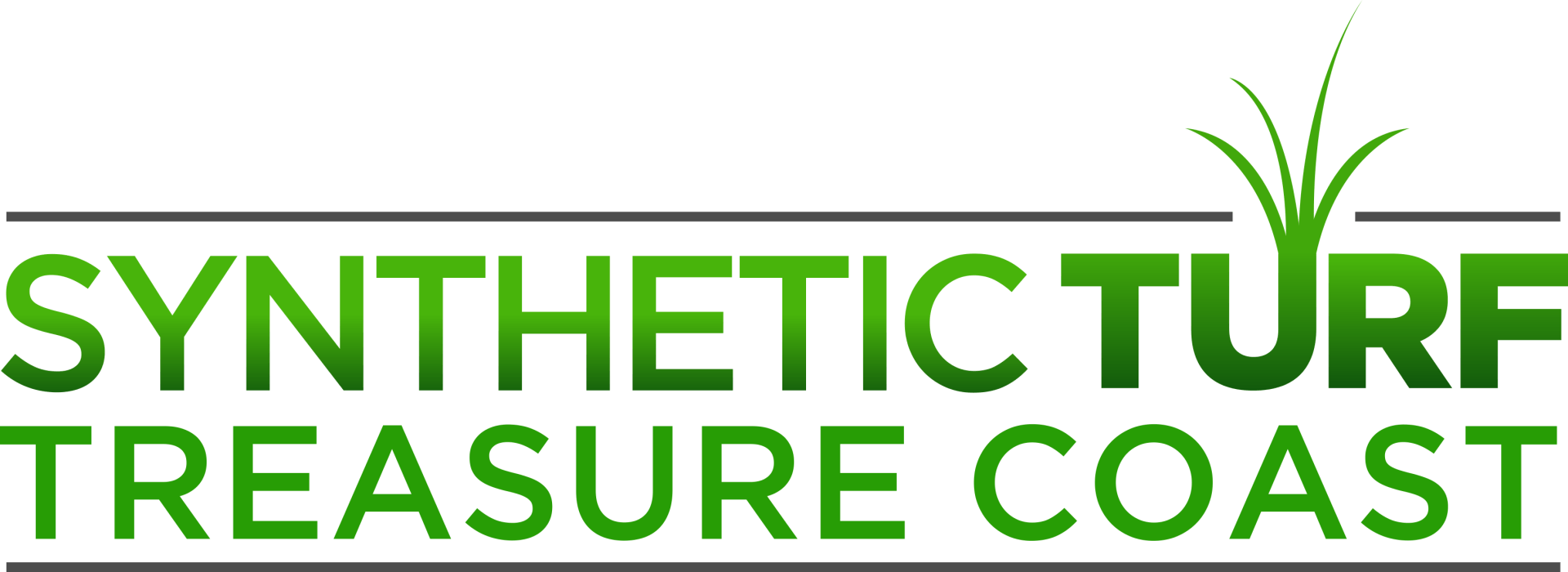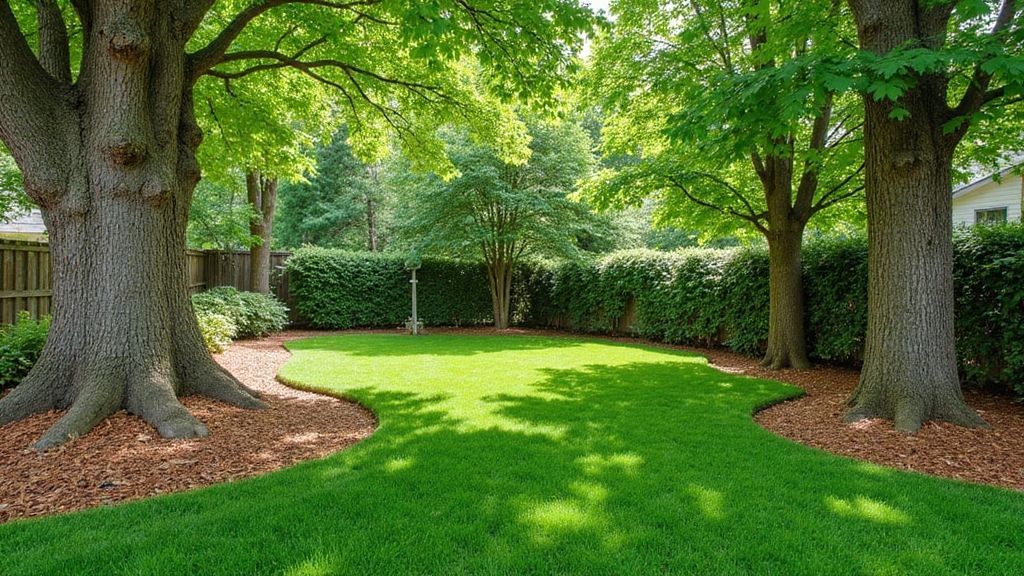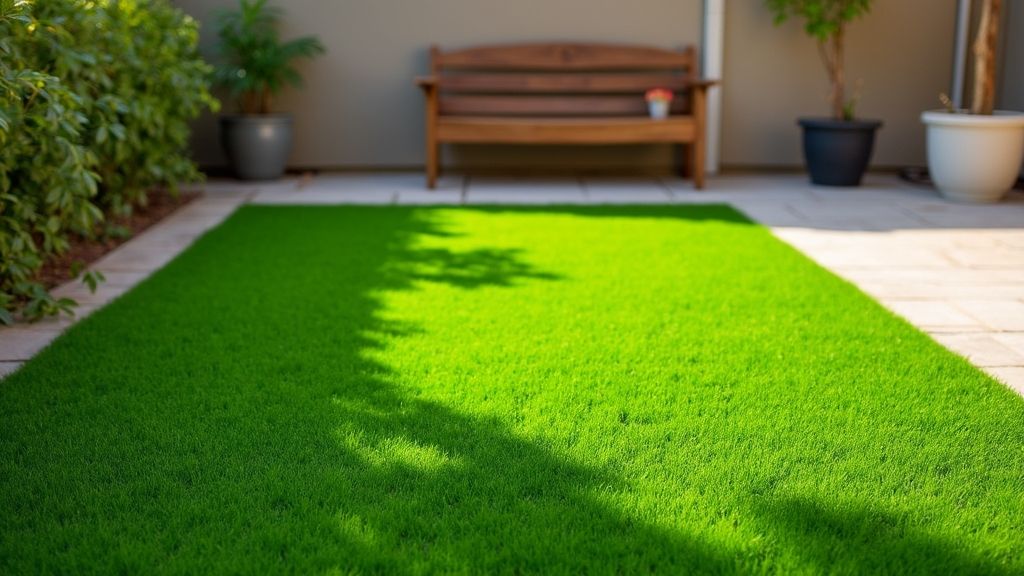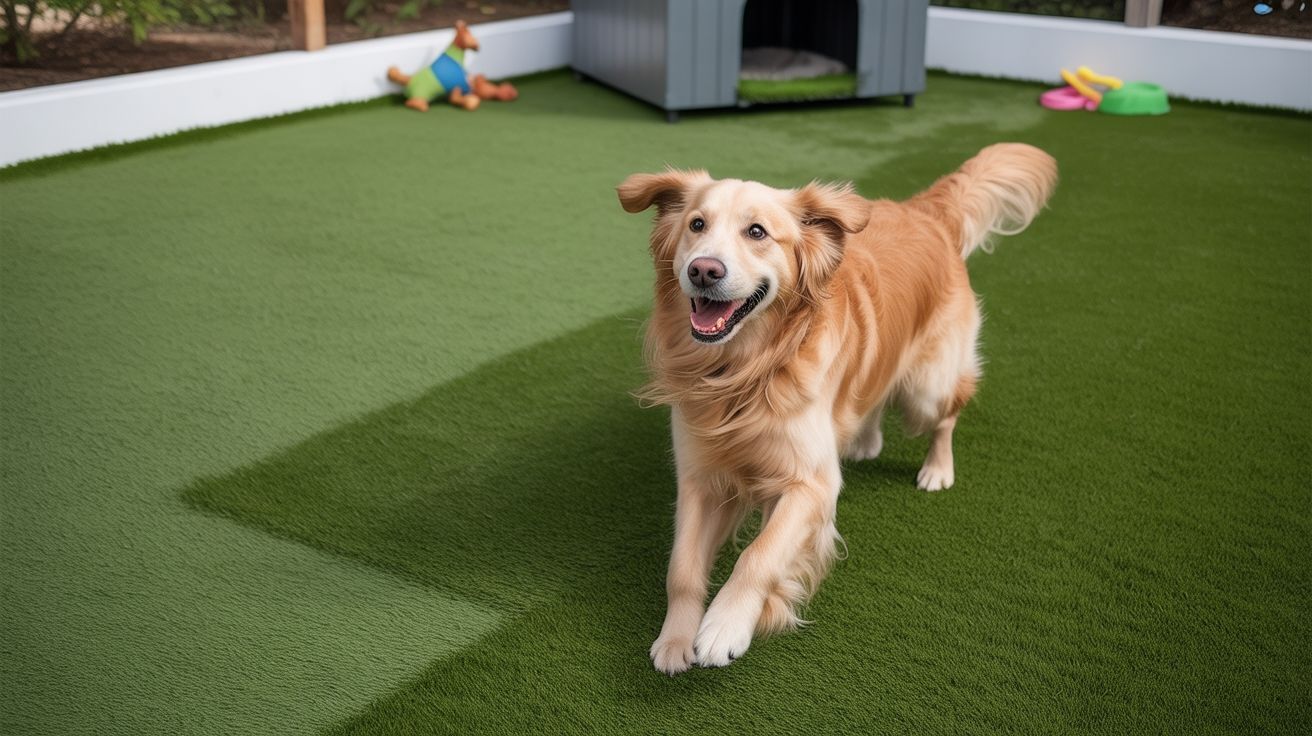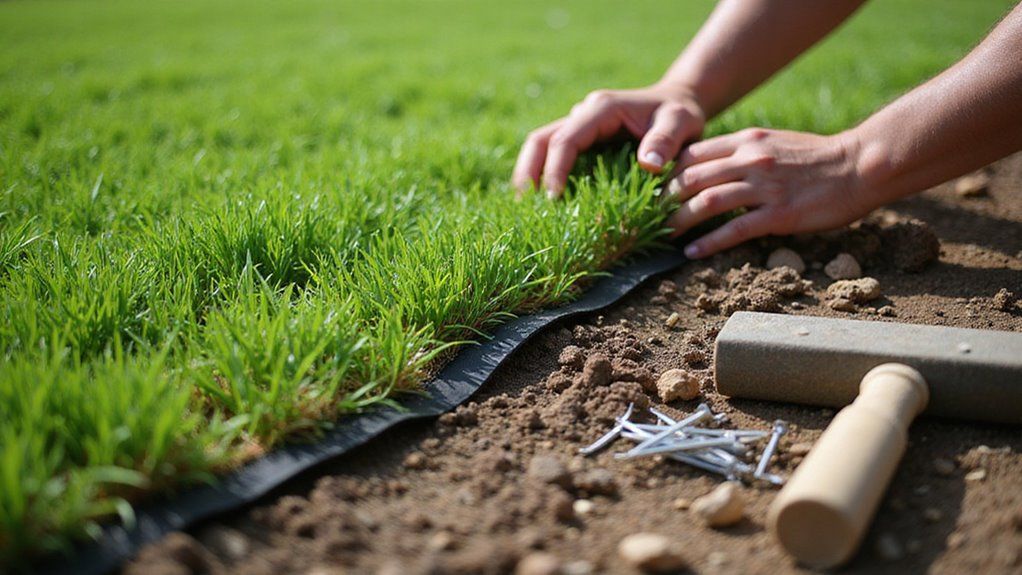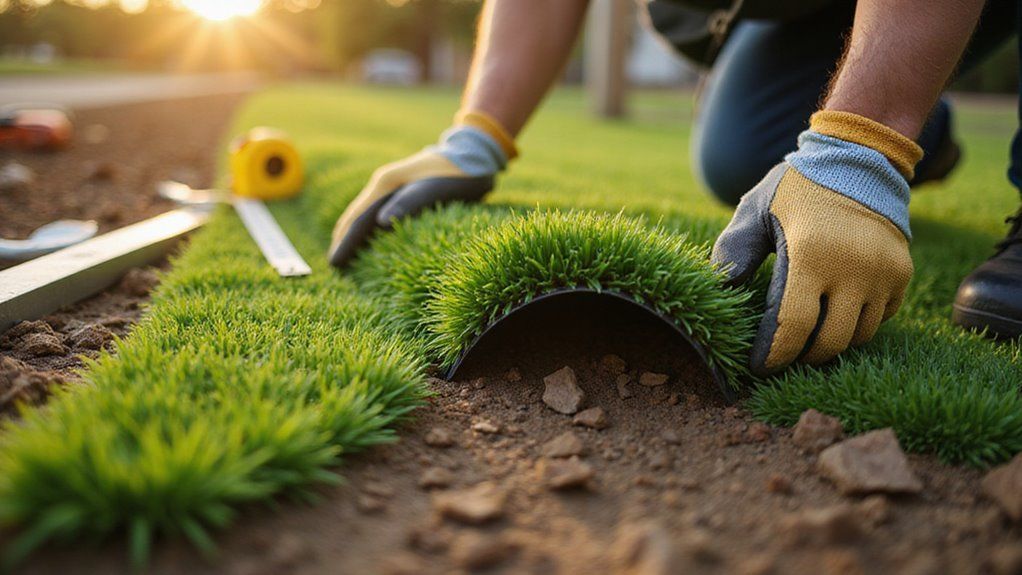What Is the Best Base for Under Artificial Grass?
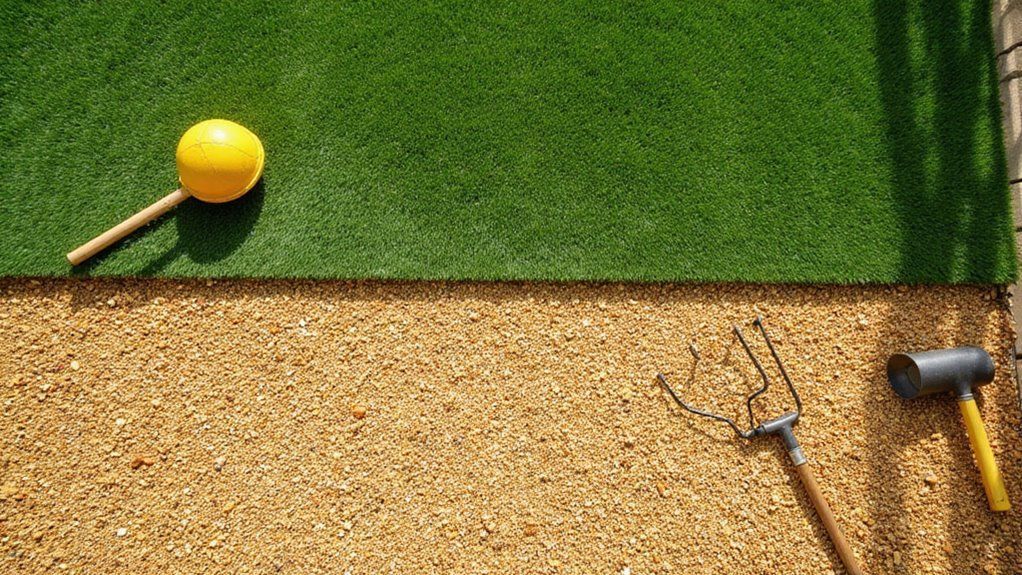
Choosing the right base for artificial grass is often confusing. Many homeowners worry the wrong choice could ruin their investment. A poor base can cause sinking, drainage issues, or weed growth that shortens the life of your turf.
These problems often show up months after installation. Uneven surfaces, puddles, and weeds can force costly repairs. No one wants their dream lawn to look bad or feel unsafe so soon.
The best base for under artificial grass is a layer of crushed granite or decomposed granite. These materials provide a stable, well-draining, and weed-resistant foundation. They help your artificial grass last longer and look better.
This blog will guide you step by step to choose and install the right base for your artificial grass project.
Key Takeaways
- Crushed granite, decomposed granite, or Class II road base are the best bases for artificial grass due to superior drainage and stability.
- Proper site preparation—removing grass, roots, and debris—ensures a stable, even foundation for turf installation.
- A well-compacted base with a 1–2% slope away from structures prevents water pooling and turf damage.
- Geotextile fabric under the base helps prevent weed growth and keeps base layers separate for added durability.
- Investing in high-quality, permeable base materials reduces long-term maintenance and extends the lifespan of artificial grass.
Understanding the Role of a Base Layer
A base layer is the foundation for artificial grass. It keeps the turf stable, drains water, and helps the grass last longer. Good preparation of the base is important for a strong lawn. Many people in coastal towns like Tequesta, Florida, appreciate a charming peaceful atmosphere that artificial lawns can help achieve by staying neat and low-maintenance.
Proper soil preparation is the first step. You should remove all grass, roots, and debris before starting. If you skip this, the ground may become uneven and not drain well.
Weed control is also necessary. If weeds are not removed, they can grow through the turf and cause bumps. This can make repairs costly and the lawn unattractive.
For best results, consider using crushed rock or gravel as your base material, as this helps with drainage and provides a firm, stable surface for your artificial turf.
Key Factors to Consider When Choosing a Base
After preparing the ground and removing weeds, choosing the right base is essential. The base supports the artificial grass and helps it last longer. Good drainage, stability, and durability are key. Selecting a base that maintains surface uniformity will also help prevent issues like uneven wear and improve safety during play.
Selecting the right base is crucial for artificial grass—ensuring lasting support, strong drainage, and overall durability.
Soil testing helps you check if the ground is stable and drains well. If the soil is too loose or too dense, the surface may sink or become uneven. Use a compaction meter for accurate results.
Proper drainage prevents water from pooling on the surface. If drainage is poor, slope the base 2% away from the main area. This helps water move away from the turf.
Material quality affects how long your installation will last. Angular aggregates are best because they lock together and stay in place. Avoid round stones as they shift more easily.
UV protection keeps both the turf and the base material from breaking down. If your area gets a lot of sun, choose UV-stabilized turf. This step helps your lawn stay green and strong for years.
For example, using a gravel base is a popular choice because it is easy to install, improves drainage, and provides a forgiving surface for synthetic grass.
Crushed Stone: A Popular Choice Explained
You’ll find that crushed stone offers excellent drainage efficiency, preventing water from pooling beneath your artificial grass. Its angular particles interlock tightly, allowing for superior compaction and long-term stability. Choose the correct gradation to optimize both performance and durability for your installation.
Crushed stone is favored as a base because it contributes to the long-term durability and low-maintenance benefits that make artificial turf a practical solution for high-use areas. Selecting a proper base material like crushed stone ensures that your installation incorporates adequate drainage systems for reliable use in various weather conditions.
Drainage Efficiency and Performance
Artificial grass needs good drainage to work well. Crushed stone is the best base material for this purpose. It lets water flow through quickly and prevents puddles.
Crushed stone has sharp edges that create spaces for water to pass. If you use well-graded stone, like 3/8” or 3/4” granite, it works even better. Proper installation at the right depth helps water move away from the surface.
This method keeps your artificial lawn looking good for longer. It also protects the ground underneath from too much water. If you want a long-lasting artificial turf, crushed stone is a smart choice.
Compaction and Stability
Crushed stone is the best base for artificial grass because it compacts well and stays stable over time. This material resists shifting and settling, which keeps the surface even. If you want a long-lasting result, choose crushed stone as your base.
Soil testing should be done before installation to check how much weight the ground can hold and how well it drains water. Proper compaction with a vibrating plate compactor is important for a dense, solid layer. This step helps prevent bumps and uneven spots on your turf.
Crushed stone spreads weight evenly and helps stop the turf from sagging. It also keeps weeds from growing up and blocks roots from pushing through. If you need good drainage, crushed stone lets water flow through easily.
This base reduces the chance of erosion and washout, so your turf stays in place during heavy rain. Most site conditions work with crushed stone after soil testing. Crushed stone is inert and often comes from local sources, which can lower transport pollution.
Decomposed Granite: Benefits and Drawbacks
Decomposed granite (DG) is a common base for artificial grass because it compacts well and drains water easily. DG forms a stable surface that keeps turf level and helps prevent puddles. It works well in areas with heavy foot traffic. Choosing DG as a base also supports minimal maintenance since it remains durable and resilient under regular use.
Soil testing is important before using DG. Test the soil to check if it drains well and can support weight. DG is simple to spread and makes it easy to create a flat surface.
DG has some drawbacks. Mining and moving granite can harm the environment. If you live in a place with freezing winters, DG may shift and need extra care.
If you want a strong and smooth surface, DG is a good choice. Always balance the benefits with your project needs and environmental concerns.
Also, keep in mind the importance of proper drainage when choosing and installing your base material to help prevent water accumulation under your artificial turf. Proper planning helps you get the best results with DG.
Class II Road Base: Strength and Stability
When you choose Class II road base for artificial grass, you’re selecting a material engineered for high load-bearing capacity and long-term stability. Its optimal particle size distribution ensures efficient drainage and superior compaction, minimizing settling and surface movement.
You'll find this base especially effective for high-traffic landscapes and installations requiring lasting structural support. For the best results, many artificial turf installers in Sewall's Point, FL, recommend Class II road base to achieve long-lasting and aesthetically pleasing turf installations.
Efficient drainage and compaction are also vital for maintaining a low-maintenance yard, as highlighted in expert guides for the best artificial grass bases.
Load-Bearing Capabilities
Artificial grass needs a strong base to support weight and daily use. The base material must prevent shifting, sinking, and uneven surfaces. Good load-bearing capability is essential for durability.
Class II Road Base is a solid option because it packs tightly and resists movement. This material mixes crushed rock with fine particles for extra strength. If you use this base, your artificial grass will likely last longer.
Always test the soil before installing a base. Soil testing shows if the ground is weak or needs improvement. You may need to add amendments if the soil is loose or unstable.
A strong base helps spread weight across the surface. This reduces the chance of dents or bumps in high-traffic areas. Proper preparation supports turf that looks and feels even.
Select a base material that has a proven track record of strength. If you prepare the site well, the grass will remain stable. Consistent results come from careful planning and solid foundations.
Drainage and Compaction
A good base must support weight and drain water well. Proper drainage starts with testing your soil type and how well it absorbs water. This helps you decide the depth and type of base needed.
Choose Class II Road Base with crushed stones of different sizes. This mix lets water pass and helps the base lock together when compacted. If you use poorly graded materials, water may not drain and the base could shift.
Install the base in thin layers. Use a plate compactor on each layer for a firm, stable surface. If you skip this step, you may get uneven or soggy spots.
Place edge restraints to stop the base from spreading out. These keep the edges strong and prevent movement. Good materials and careful work keep your artificial grass flat and dry.
Sand as a Base Material: Pros and Cons
Sand is a common base material for artificial grass because it is cheap and easy to use. It helps level the ground quickly and makes installation simpler. However, sand is not always the best choice for every yard.
Modern artificial turf trends emphasize lifelike results, so choosing the right base impacts both appearance and function. Sand allows for fast compaction but may not suit areas with poor drainage.
Homeowners should test their soil before laying sand to avoid water problems. If the soil drains poorly, sand could make flooding worse.
Sand's loose texture lets weeds grow easily. You must use strong weed barriers to keep your lawn clean. If you want less maintenance, consider other base materials. To create an inviting and visually appealing outdoor space, proper base preparation is as essential as selecting authentic-looking turf.
Sand can shift or wash away, especially with heavy foot traffic or rain. This movement may lead to an uneven surface over time. For better stability, a crushed stone base may be a better option.
If you’re preparing your space for new turf near places like limited parking facilities at William G. Myers Park, considering drainage and stability is especially important.
Recycled Concrete Aggregate Options
When you consider recycled concrete aggregate (RCA) for your artificial grass base, you’re working with crushed concrete sourced from demolition or construction waste. RCA offers reliable drainage performance due to its angular particle structure, which helps prevent water pooling.
You'll find that proper installation directly impacts compaction, stability, and the long-term durability of your turf system. Using RCA as a sub-base is especially beneficial for high-traffic areas because it adds durability and reduces the risk of surface shifting. For inspiration on sustainable landscaping, consider how preserving nature for future generations is prioritized at local nature centers.
Material Composition and Sourcing
The base layer controls how well your artificial grass performs and how long it lasts. Recycled concrete aggregate (RCA) is a strong and eco-friendly choice for this layer. RCA comes from processed demolition waste, making it both reliable and sustainable.
If you use RCA, make sure it comes from trusted suppliers with good quality control. Check that the particle sizes are well mixed for even compaction. The material should be free from rebar, asphalt, and organic debris.
RCA should have consistent moisture for easy installation. Local sourcing helps reduce both transport costs and environmental impact. Selecting the right RCA ensures your artificial grass will have a sturdy foundation.
Drainage Capabilities Overview
Recycled concrete aggregate (RCA) drains water well under artificial grass. Its mixed particle sizes let water pass through easily. Good drainage helps artificial grass last longer and perform better.
Soil testing should be done before laying RCA. This will show if poor native soil drainage could cause problems. If drainage is bad, extra steps may be needed.
RCA works as well as traditional stone for drainage. It also helps the environment by using waste and saving natural resources. Always check RCA for clean material and proper size mix.
If RCA is dirty or not graded right, drainage can suffer. Clean, well-graded RCA will reduce the chance of clogging. Proper installation will help your artificial grass system stay dry and stable.
Installation and Longevity
Recycled concrete aggregate (RCA) works well under artificial grass if installed correctly. Proper installation helps the surface last longer and perform better. If you skip steps, drainage and stability may suffer.
Soil testing checks if the ground can support the RCA and drains well. RCA must be compacted in thin layers for a firm, even base. If the base is uneven, the surface may shift or settle later.
Geotextile fabric goes between soil and RCA to stop weeds and keep layers separate. The base should be graded so water drains away from the area.
If you want a certain look, choose RCA blends that match your style. Correct installation is important for a long-lasting, reliable surface.
Specialty Foam Pads for Cushion and Safety
Specialty foam pads help make artificial grass safer and more comfortable. They absorb impacts and lower the chance of injuries from falls. These pads are useful for playgrounds, sports fields, and home lawns.
Foam pads sit under the turf and do not harm the grass above. They spread weight evenly to stop early damage to turf fibers. If you want a smooth yard, these pads also hide small bumps in the ground.
Choose foam pads made for outdoor use to get the best results. They should resist sunlight and bounce back after being pressed. Pick a pad thickness that matches how the area will be used. By adding foam pads, you help create an even surface that reduces the risk of falls, twists, or sprains during sports and regular use.
Drainage Considerations for Artificial Grass
To ensure effective drainage under artificial grass, you’ll need to choose permeable base materials like crushed granite or limestone.
Proper slope and grading direct water away from the surface, helping you prevent pooling and maintain turf integrity. Address these factors during installation so your artificial lawn performs reliably in all weather conditions.
Permeable Base Materials
Permeable base materials are important beneath artificial grass because they allow water to drain away easily. Good drainage prevents puddles, mold, and damage to the turf. If the base is not permeable, water can collect and cause problems.
Permeable materials also keep the artificial grass stable and level. They help manage water under the surface, which protects your lawn over time. Without proper drainage, your synthetic turf may not last as long.
These materials offer several key benefits. Rapid water flow prevents standing water and flooding. Good aeration reduces compaction and keeps the ground healthy.
Permeable bases also handle freezing and thawing better, which stops shifting and damage. They limit weed growth by not letting water sit in one place. A stable base keeps your lawn even and safe to use.
If you want the best results, use materials like crushed granite or decomposed granite. Class II road base is also a good option. These choices provide both drainage and durability for artificial grass installations.
Slope and Grading
Efficient water drainage in artificial grass starts with setting the right slope. Always test the soil to check how well it drains. If the soil drains poorly, you may need extra drainage solutions.
Set a slope of 1-2% away from buildings or patios. This slight angle guides water off the surface and prevents puddles. Use tools like laser levels or string lines to keep the slope even.
Compact the base soil firmly to stop it from shifting later. Avoid steep slopes, as they can look odd and may be unsafe. Proper grading keeps your artificial grass looking good and working well.
Preventing Water Pooling
Water pooling can still happen even if the ground is graded well. Good drainage is the key to stopping water from collecting. If water pools, it can harm artificial grass and lead to mold.
A strong base made from crushed granite or limestone allows water to pass through easily. If you use a geotextile membrane, it keeps soil from blocking water flow.
Perforated drainage pipes help if your area gets a lot of rain or has heavy clay soil.
Always compact the base in layers to prevent dips that collect water.
The finished base should sit slightly higher than the ground around it. This setup helps water run off quickly and keeps your lawn looking good.
Preparing and Compacting the Sub-Base
Preparing and compacting the sub-base is necessary for strong and stable artificial grass. This step helps your lawn last longer and drain well.
Remove the old soil to a depth of 3–4 inches. Clear away any roots or debris you find. If you skip this, the grass may become uneven later.
Fill the area with crushed granite or MOT Type 1. These materials allow water to drain and support the grass.
Use a plate compactor to create a flat, firm surface. Proper compaction keeps the base from sinking. It also prevents bumps or dips in your lawn.
Weed Barriers and Their Importance
Weed barriers are important because they stop weeds from growing under artificial turf. These barriers are usually made from landscape fabric that keeps weeds out. If you install a weed barrier, you will need less maintenance later.
A good weed barrier blocks sunlight so weeds cannot sprout. It still lets water and air pass through for proper drainage. If you choose a permeable fabric, your turf will last longer.
Proper installation creates a stable layer between the ground and the turf. The barrier helps keep the surface even and prevents weeds from disturbing your turf. If you use a weed barrier, your artificial grass will look better and last longer.
Addressing Slope and Grading for Water Flow
To make sure water drains well under artificial grass, always create a gentle slope. Use a 2% slope going away from buildings. This helps move water and stops puddles from forming.
Create a gentle 2% slope away from buildings to ensure water drains properly and prevent puddles under artificial grass.
Compact the soil before you add any base material. Firm soil keeps the ground stable and helps water flow. If you skip this step, the ground may settle unevenly.
Spread crushed granite or limestone in thin layers. Compact each layer to keep the base strong and let water pass through. Always check for low spots and fill them in.
Proper grading stops water from gathering and keeps weeds from growing. If you grade carefully, your artificial grass will last longer. Good drainage means fewer problems in the future.
Common Mistakes to Avoid During Installation
Avoiding mistakes during artificial grass installation is important for a long-lasting result. Small errors can cause drainage issues and uneven surfaces. Careful attention to each step helps prevent these problems.
Soil testing is necessary to check for good drainage and proper compaction. If you skip this step, your lawn may develop soft spots or hold water. Always test before installing the grass.
Remove all debris and organic matter from the area. If you leave any behind, the surface may become unstable over time. Clean the site completely before laying the base.
Choose high-quality base materials that provide strong support and allow water to drain. Using poor materials can cause the grass to shift or puddle. Good materials help keep the turf in place.
Compact the sub-base in even layers to avoid bumps and dips in your lawn. If this step is ignored, the grass surface will look uneven. Take your time to do this correctly.
Edge restraints are important to keep the grass secure and tidy. If you skip them, the edges may lift or spread out. Proper restraints give your lawn a neat, professional look.
Comparing Costs and Maintenance Needs
Crushed stone and decomposed granite cost more at first but last longer and drain water well. Sand and gravel are cheaper but may need more upkeep later. If you want low maintenance, a strong base is a better choice.
A well-compacted base helps prevent the turf from becoming uneven over time. It also cuts down on the need for repairs and extra work. If you install the base yourself, mistakes could lead to higher costs later.
Professional installation may cost more at first but can save money by avoiding problems. Choosing the right base keeps your artificial grass stable and easy to care for. Consider both the upfront and long-term costs when making your decision.
Conclusion
If you want your artificial grass to last, you need a strong and stable base. Crushed granite or decomposed granite works best. These materials provide good drainage and prevent uneven surfaces.
If you prepare the ground properly, your lawn will stay beautiful and easy to maintain. Adding a weed barrier helps keep unwanted plants away. Good grading ensures water will not pool on your turf.
If you choose the right base and take time with installation, you will enjoy a perfect lawn. For the best results, trust the experts. Install your artificial grass with Synthetic Turf Treasure Coast.
About the author
Kathy Leavell
Kathy Leavell is the founder and owner of Synthetic Turf Treasure Coast, a leading provider of synthetic grass solutions for residential and commercial properties in Florida. With over a decade of experience in the industry, Kathy has become a recognized expert in synthetic turf installation, maintenance, and repair. Under her leadership, Synthetic Turf Treasure Coast has earned a reputation for exceptional customer service and high-quality workmanship.
Prior to starting her own business, Kathy worked in sales and marketing roles at several major synthetic turf manufacturers.
